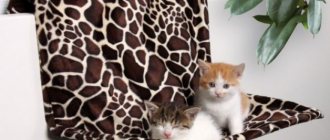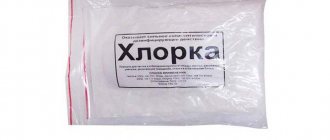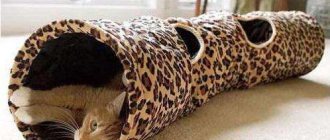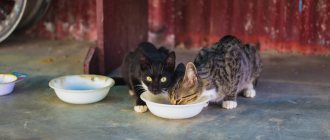When you go to a pet store, you can be quite confused by both the number of carrier bags for cats on offer and the prices for them. If you travel frequently and take your pet on trips, then it is definitely better to invest in a good mobile home. For example, the plastic containers we offer are best suited for flights. But if your cat rarely goes outside in a carrier, then you can easily make a bag yourself. This way you will save your budget and develop the design yourself. How to sew a carrier bag for a cat? You will find patterns and tips in this article.
Choosing material for carrying
When choosing fabric, you should consider the time at which the pet house will be used. Ideally, it is better to make several carrier bags for your cat. Each season has its own apartment for trips.
For summer cat travel, look to fabrics that are thick but breathable. These include jeans, raincoat fabric and the like. Make sure your pet doesn't get bored during the trip. To do this, make a window so that he can admire the surroundings. Any transparent fabric or mosquito net will do.
For winter trips you need warmer material. Pay attention to the fleece. A mesh is also necessary, but you should make sure that it can be closed tightly and that it does not release heat.
To make a fabric cat carrier, you don’t have to buy new material. You can use an old jacket or bag. These should be used to make the main parts for carrying. All you need to purchase for sewing: finishing fabric, zippers and insulation.
The bottom of the carrier must be hard. This is necessary so that the cat feels comfortable while moving due to the stability of its position. For the base, use materials of appropriate rigidity: plastic, plywood or fiberboard. You can make the bottom cardboard. However, it will not last long. Under the weight of the cat, the cardboard will begin to sag, and ultimately the carrier will become unusable.
Main types of bags
Recently, the variety of models has been encouraging. Not just bags were invented - they were transformed into fashionable sports backpacks, trolley suitcases on wheels, stylish baskets and hard plastic boxes with prudent placement of food and drinking water for long journeys.
Convenient accessories have become not only a means of carrying animals, but also organically fit into the owner’s clothing style. The material used in production is also varied: plastic and fabric, leather and natural vine twigs are used.
All vehicles for cats can be divided into the following types:
- frame bags-tents;
- plastic boxes;
- cells;
- fabric folding carriers with a rigid base;
- comfortable suitcases with food and toilet;
- other (backpacks, baskets).
From fabric
Advantages of fabric carriers:
- lungs;
- can be folded (do not take up much space during storage);
- inexpensive;
- easy to wash.
Such textile, practical and lightweight bags are indispensable for visits to the veterinarian, trips to the country or for a short walk. They are not suitable for long-term transportation. The presence of a zipper allows you to either close the lid tightly or leave an open area for the cat to see. The disadvantage is that such a bag absorbs the smell of the animal and requires constant washing. The average price fluctuates around 2 thousand rubles.
Plastic box
The best representative of plastic boxes may be the “Trendy “Wild World” with a metal door that is secured with a reliable latch lock. The container is made of environmentally friendly plastic and has lattice inserts on the sides. The spacious box will accommodate a toilet tray, food and water container. However, the cat's weight is limited to 5 kg.
Frame
Successful and convenient combination of material, mesh and rigid frame. It looks like a tent with mesh windows. The animal likes such a house. It protects well and has excellent visibility and ventilation at the same time. A lightweight tent does not fold due to the rigidity of the frame.
Basket
Perhaps the most stylish bag. Curver Petlife will especially appeal to female representatives who go on vacation with their beloved pets. The bag is spacious and riddled with a lot of small holes - the cat is provided with excellent ventilation. The reliable plastic handle can be attached to the car interior, and the plastic clip-fasteners both decorate and hold the lid firmly.
Backpack
This accessory is more suitable for displaying a beautiful expensive item by the owner. The backpack really looks beautiful and impressive. The ventilation is well thought out, and the presence of a “porthole” allows the cat to see what is happening around. It is also convenient to have many pockets. However, a huge disadvantage is the lack of contact between the owner and the animal, which can lead to stress for the latter.
What tools are useful for sewing?
To make a carrier bag for a cat with your own hands, you need to stock up on some materials:
- First of all, these are fabrics. You select them based on the criteria described above. Remember that two types of fabrics are needed: main and lining.
- Foam rubber for softness of the product.
- Lightning. There may be several of them. The number of zippers in the bag will depend on the pattern chosen.
- A piece of plywood or plastic to strengthen the bottom.
- Sewing machine.
- Non-woven base for strengthening seams.
- Mosquito net to protect the viewing window.
- Pens. You can take them from your old bag.
Benefits of soft carriers
Unlike hard plastic baskets or metal cages, the animal feels more protected in a soft, cozy house. There is always an opportunity to hide from prying eyes, to hide from danger. This type of carrier takes up less space than a rectangular plastic box. In addition, through the flexible walls you can stroke and calm a pet frightened by an unfamiliar place, which may react inappropriately to a hand inserted inside, scratching the owner.
Self-tailoring provides ample opportunities for flights of fancy when decorating. All kinds of fabrics of original colors, beads, ribbons, buttons, braid, and other decorations are suitable for this. The bag can be made in the form of a familiar ladies' accessory. If the owner sewed such a carrier herself, she has the opportunity not to part with her pet even in those places where pets are usually closed.
Since making a mobile house for a pet is not particularly difficult for those who know how to operate a sewing machine, you can create a whole collection of designer attributes for different occasions: a light bag for the warm season, an insulated one for the winter, an elegant one for a trip to the guests, extravagant - for visiting tailed animals exhibitions.
In addition, an original portable bag for a cat, handmade and lovingly sewn to its individual dimensions, will be an excellent gift for a lover of these wayward pets.
Taking measurements from a cat
This is the main and mandatory condition. To create a comfortable carrier bag for a cat with your own hands, you need to know some of the dimensions of your pet. In particular, the length and height of the animal.
The cat's length is measured from the inside of the front paw to the tail. Height - from paw to neck. The length and height of the container are determined.
The size of the carrier bag should be made comfortable for the cat. This means that the pet must be able to move freely in its travel house: be able to turn around and stand up to its full height. To create comfortable conditions for the animal, multiply the indicated measurements (length and height of the carrier) by 1.5.
What is a cat carrier?
Photo of a cat carrier.
A reliable, convenient device that does not restrict the movement of a pet, but at the same time does not allow it to jump out, designed for the safe and comfortable transportation of an animal - this is what a carrier bag is. It is also called a cat container.
There are several requirements that you should adhere to when choosing a carrier for your cat:
- it must correspond to the dimensions of the animal;
- have reliable fastenings;
- provide air ventilation.
Semicircular carrying bag
When constructing this pattern, only three parts are used. In a simplified version - two. The pattern consists of front and back walls, a bottom and two sides.
In order to sew a carrier bag for a cat with your own hands, you will need the materials listed above. Namely:
- dense fabric that holds its shape, it is better to use several types (frame, lining and decorative);
- for bottom rigidity - plywood, cardboard or plastic sheet;
- foam;
- lightning;
- pen;
- mesh to protect the window.
How to sew a semicircular shipping container?
- Cut out the main pieces from the lining and frame fabric. Insert soft material (foam rubber) between the sides. Make the bottom rigid: that is, insert plastic or plywood between the lining and the frame fabric.
- The size of the sides should correspond to the “height of the cat” plus five centimeters. Otherwise, the animal will rest against the top of the bag.
- Sweep away the details. Sew the sides to the bottom.
- Make a window out of mosquito net.
- Attach a zipper to the top side of either of the two sides.
- Cut the front and back parts of the carrier from a single piece of fabric in the shape of a rectangle.
- Sew a handle in the middle.
- Sew the parts on a machine. First sew the part where the zipper is located. After the rest.
DIY cat carrier.
When you come to a store selling the relevant goods, you may be confused by the range of carriers on offer and be surprised by their high cost.
If regular trips are coming up or this is due to the nature of the trip (for example, an airplane flight), then there is no other choice - you will have to fork out for a good store container.
But what if you rarely need a bag or you can’t afford to spend money on such a purchase?
How to make a baby carrier at home? The answer is very simple - you can make a travel bag for cats yourself with your own hands!
Material for production
As mentioned above, the main materials for the production of carriers are plastic and fabric. If you have to make a bag for a cat at home, then it will be a fabric carrier, since every craftswoman or just a beginning needleworker will have everything they need.
So, in order to sew a means of transportation for your fluffy, you need to prepare:
- thick fabric (jeans, leather);
- lining fabric (Not synthetic! For example, cotton)
- thick cardboard for the base of the bag;
- paper on which the pattern of a house for cat trips will be drawn;
- sewing kit;
- lightning;
- mesh material.
Shoulder bag
In the photo you can see that the pattern of this carrier is simple and unpretentious. It is very easy to sew. The photo shows a detailed diagram with the necessary symbols.
- Cut out the parts of the required size from a piece of paper.
- Place the pattern on the main and lining fabrics and foam. Cut them taking into account the seam allowances.
- Sew the side pieces on two types of fabric. Place foam inside.
- Sew the bottom of the bag to the side (main fabric).
- Repeat with the same pieces with the lining.
- Place foam rubber between the main and lining fabrics.
- Baste the side seam.
- The zipper will be located on the top of the bag. Sew it on.
- Make the handles the length you think is necessary.
- Sew them on.
Bag with four zippers
The calculation is based on a medium-sized cat. To make this carry, you will need the following:
- one square meter of main and lining fabric, foam rubber (you can use synthetic padding instead);
- four lightning bolts;
- Velcro;
- plywood measuring 20 by 40 cm;
- mesh - 45 by 20 cm;
- pens.
Let's look at step by step how to sew a carrier bag for cats with your own hands using a pattern. It will have a lot of lightning.
- Enlarge the pattern shown in the photo to the desired size. For convenience, the places for each zipper are marked in different colors.
- Place the main and lining fabrics together.
- Prepare the details using the paper pattern. Cut them with a one centimeter seam allowance.
- Open the back pocket.
- Do the same steps with foam rubber.
- Carefully cut a hole in the fabric for the window.
- Make a window from a mosquito net. The size is indicated in the photo. Don't forget about seam allowances.
- Reinforce the bottom with rigid material: plywood or cardboard.
- Baste the pieces and stitch them on the machine.
- Now we need to deal with the lightning. The photo shows exactly how they need to be sewn in. The zippers should close from the corners of the carry.
- Sew the top flap of the container to the cross section of the bag. This place is marked with a cross in the photo. Zippers number 4 and 5 should secure the flap.
- Sew a handle on top. The carrying bag is ready!
Master class on making a bag
Let's take a step-by-step look at sewing a carrier bag for a small cat or kittens.
Convenient bag for a small cat
Such a bag can be sewn, for example, from an old raincoat. In this example, the bottom and top are stitched. It is recommended to use fabric that is not very thick so that it can be sewn on a sewing machine. The bag consists of the following parts:
- the upper part is a rectangular piece measuring 32*55 cm;
- the bottom of the bag is a rectangular piece measuring 32*20.5 cm;
- two sidewalls;
- pens.
The sidewalls can be cut out in parts; mesh windows are made in each sidewall.
Dimensions are shown without seam allowances.
Beginning of work
Let's make patterns for the main parts of the bag on paper and cut out the parts from fabric.
Photo gallery of getting started
Making pens
- Let's cut out strips for handles 6 cm wide (without allowances).
- We will sew the strips together, the length of the handles we need is 2 meters (both handles together, no need to cut).
- Iron the strip to the center, do not process the edges, they will be covered with ribbon, the width of the strip is 3 cm.
- Attach the ribbon from the raw edges.
Let's cut out strips for handles 6 cm wide
It is better to choose a thick braid to strengthen the handles.
We will sew the braid along the entire length
Making the top of a bag with handles
The procedure for sewing the top:
- Sew the top and bottom of the main fabric on one side.
- We outline where the handles and pocket will be.
- We sew one handle on the side where the pocket will be, that is, we sew the edges of the pocket with a handle.
- We cut out a pocket from the mesh and sew it in (pocket size 15*20 cm).
- We sew the bottom to what we have outlined with braid near the bottom.
Let's outline where the pens and pocket will be
The procedure for attaching handles:
- We sew the ribbon at a height of 12 cm from the bottom where the second handle will be, leaving two gaps (then we will insert the second handle there).
- Leave a small end of the ribbon free for the handles.
- We sew on the right side of the pocket approximately 12 cm up.
- We leave the handle itself free (56 cm) and sew 12 cm down.
- We pin off the remaining end with a pin so that it does not interfere.
Photo gallery illustrating the progress of attaching the handles
Sewing bottom and top
Operating procedure:
- We cut out the bottom and top from the main fabric and for the lining.
- We cut out the bottom and top from padding polyester, but without seam allowances.
- Immediately stitch it to the lining, as if fastening it with several seams, covering the padding polyester side with chintz (then it will be more convenient to insert the lining).
- We machine sew the lining and main fabric together on 3 sides. We do not connect one long side. We will then insert a gasket through it.
- Sew the other side of the bottom to the top.
It should look like a pipe.
Photo gallery illustrating the work of making the bottom and top of the bag
Manufacturing of sidewalls
Operating procedure:
- We cut out 2 windows from the mesh.
- We sew together 3 parts at once: the lining, the mesh and the main fabric, laying the front side on the mesh.
- First we sew 2 barrels and turn them right side out and iron them.
- Sew on the top part, turn it over and iron it.
- We sew on the bottom part, sewing it as if around a window.
Photo gallery illustrating the procedure for making sidewalls
Strengthening the bag with jermaflex
Jermaflex is an environmentally friendly type of insulation produced by foaming high-pressure polyethylene.
Operating procedure:
- We place jermaflex parts between the main fabric and the lining for rigidity.
- Let's stitch along the edge.
- Sew the finished sides to the bottom.
- We cut out a 32x55 cm pad from jermaflex and insert it into the top of the bag between the main fabric and the lining (we had one side unsewn for this).
- We sew in zippers on both sides.
You can also add a zipper at the top of the bag. Then the gasket can be installed last.
Photo gallery illustrating working with jermaflex
Work to strengthen the bottom and cuts
Operating procedure:
- We cut the bottom out of plywood or fibreboard (fibreboard).
- It also inserts between fabrics.
- We cover all open sections with narrow strips of fabric (bias tape).
How to make friends with a cat with a new bag? Some tips
A cat is an animal with a wayward character. And it may well happen that the bag you made with love and care will be rejected by your pet. The first option is to force the cat into the carrier. However, this will cause serious stress for the animal. In addition, there will be scratches on your hands. What to do in this case?
The cat should be “introduced” to the carrier bag you made yourself. The pet should associate it with something positive and calm. The cat needs several days to get used to its moving house.
Decorating a bag
When the main work of making the bag is completed, you can begin decorating.
Rhinestones, beads, threads, seed beads, applique, and fur are used for decoration. Decoration depends on the tastes of the housewife, the decorations at hand and imagination.
The carrying bag can be decorated with a fabric applique
Decorating a bag with beads
The following types of bead decoration are distinguished:
- Embroidery. This method is used primarily for decorating fabric accessories (silk, denim, cotton). In addition to beads, you can use rhinestones, coins, and ribbons.
- Pasting. It is suitable for leather, plastic, oilcloth and suede bags. Only use clear quick-fix adhesive. You will also need tweezers and a clean cloth to remove excess composition. After registration, the decor should completely stick together, this will take about two days.
Before registration, you need to create a sketch of the future drawing. This will allow you to evaluate the color compatibility and the result in advance.
The bag can be decorated with bead appliqué. The future decoration is woven separately and then simply glued or sewn to the bag. You can use this method if you plan to create a small beautiful accent on the bag in the form of a flower or a funny character.
Video tutorial on making beaded jewelry for decorating a bag
The video tutorial demonstrates how to make a bright brooch from beads on felt. The brooch can be used to decorate a bag.
Which bag shape do you prefer?
Several options for baby carrier patterns were presented above. Each of them is easy to sew. When choosing a form, you should focus on your preferences. A hand-sewn cat carrier bag with long handles will allow you to carry it on your shoulder. Your hands will remain free. A semicircular carrier is more suitable for medium-sized cats. A large number of zippers on the bag will allow you to reach your finicky pet from any direction. The choice is ultimately yours!
Author: Lyudmila Perepelkina
Types of carriers
House for a cat: options for how to make it yourself
There are now different designs available to carry different types of cats, so it is worth knowing them to make it easier to choose.
Bags
A cat carrier that looks like an ordinary woman's bag is a rather impractical purchase if we consider the situation when the pet is quite large and needs to be carried over a long distance. Some models have wheels that allow you to transport the animal.
Soft carriers are more suitable for kittens, since they are small in size. Such carriers should have thick enough walls and bottom so that the cat feels comfortable inside.
The bag should have a hard bottom so that the pet can sit comfortably in it.
Important! When purchasing, you should pay attention to the quality of the walls and frame. In the first case, after pressing on the carrier, it should bend, but then return to its previous state. In the second, the flexibility of a plastic stick is tested by bending it.
This carrier is suitable for both big cats and kittens. The walls do not hinder the animal’s movements; the pet can calmly stand on the bottom. A mesh window is not suitable for rambunctious cats as it will not withstand the pressure of claws.
For your information! Sometimes such models have fabric partitions that allow you to carry 2 cats in one carrier at the same time.
Backpacks
For single travelers who want to take their pet with them on the road, it is recommended to purchase a cat carrier in the form of a backpack. In this case, your hands will be free and you won’t need to look for a place to put the cage or bag. However, a backpack for a cat is not the most favorite transport, since it will not be possible to avoid constant shaking, and therefore it is better not to carry particularly nervous animals in them.
A backpack for cats may have straps that prevent the backpack from swinging, in which case the pet will not experience any discomfort. This type of carrier is suitable for both adults and children. Often these backpacks for cats come with a porthole so that the animal can observe its movements. The sides have windows into which a large amount of air enters. Sometimes backpacks are also equipped with wheels, which are required for traveling in public transport, moving around a train station or airport.
Containers
The most popular type of carrier for cats is a plastic container. This type has many advantages over others:
- easy washing and quick drying;
- durability;
- no discomfort for the animal;
- versatility of use: can be carried over long and short distances;
- good ventilation.
However, such a plastic box also has a drawback - it is too bulky, and therefore can cause inconvenience for the cat owner. The device often has windows on all sides, and therefore does not cause problems with ventilation. But among all types of carriers, this is not the cheapest option.
A plastic cat carrier is the most convenient
Cells
A panoramic view awaits the cat from his carrier. This type is made in most cases of steel, and therefore is quite heavy. Suitable for both small kittens and adult cats. These carriers can be taken with you as hand luggage on a plane or train, you just need to cover them.
Important! It is not recommended to carry an animal in a cage during rain or cold weather, as the pet may get sick. In summer, you should also not place the cat in a cage, as it can overheat; it is necessary to cover it with a thin, light-colored cloth.











